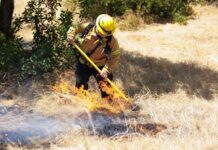After 32 years as an outcast, Jim Berkland knows the scientific
community will never accept his theories.
After 32 years as an outcast, Jim Berkland knows the scientific community will never accept his theories.
Berkland has been laughed out of the U.S. Geological Survey. His public prediction of the devastating 1989 Loma Prieta quake earned him a two-month suspension from his job as a Santa Clara County geologist. Now 76, Berkland passes his retirement predicting quakes in his monthly newsletter for a devoted audience of hundreds, ignored by geophysicists whose work is taken seriously.
“I don’t care anymore,” Berkland said from his Glen Ellen home. “They’re irrelevant. I know what happens to people who go out of the mainstream. I always tell people, don’t be afraid to challenge the authority because the authority may be wrong.”
And Berkland is definitely out of the mainstream, and after years of trying, he has found a biographer to tell his story and explain just how the moon can tell us when an earthquake is coming, and cats and dogs can tip us off to where it’s going to occur.
The author is Cal Orey, a northern California writer with a lifelong fascination of earthquakes and an affinity for animals. Her “The Man Who Predicts Earthquakes” is a defense of Berkland’s maverick theories and an appreciation of people and animals so in tune with the Earth they can predict its movements.
In fact, since she first met Berkland in 1982, Orey has come to believe that her pets know when a temblor is coming, and that she herself can predict quakes as far away as Japan.
“I’ve always been an earthquake enthusiast and had phobias and anxieties about earthquakes,” she said in a recent interview. “When I was 16, my woodshop teacher tagged me Earthquake Annie. I thought the Pacific Ocean was going to spill over the hills and drown us all.”
So far, it hasn’t, but even mainstream scientists still fear that “the big one” could destroy the state’s levee system and leave California under water. But the business of predicting quakes is a lot more art than science.
“The Holy Grail of earthquake seismology is the ability to predict them,” said San Jose State University Geology Professor Jonathan Miller. “And certainly anyone who has had any kind of success will get noticed. I wouldn’t want to bank on his predictions, but at the same time, there has been some work to see if there are some less traditional ways we might go about predicting earthquakes.”
Berkland’s odds are helped by some 5,000 quakes that shake California each year. People can feel about 200 of those.
Berkland claims to have called three out of every four quakes to hit California since 1974. He says that full and new moons cause tidal patterns that in turn cause most earthquakes, and that household pets have an uncanny sense of impending disruptions in the Earth’s crust. Simply counting ads for lost pets in newspapers is a good way to know if a quake is imminent, he says.
That’s how he knew the 7.1 Loma Prieta quake, which killed about 65 people and caused the Cypress freeway to collapse in the East Bay and a conflagration in San Francisco’s Marina district, was coming sometime during the 1989 Bay Bridge World Series between the Oakland Athletics and San Francisco Giants. On Oct. 12, 1989, Berkland called The Gilroy Dispatch to warn people to be ready for it.
“I thought, I have to tell somebody, the [San Jose] Mercury News had gone deadly silent on earthquakes,” he said.
A short item ran in the Oct. 13 Dispatch, and four days later, the quake hit. Berkland was in his county office at the time.
“For two seconds I was elated – ‘I got my quake!’ – but then I didn’t want any part of it,” he recalled. “I thought the building was going to come down. It was bouncing and shifting and quaking, all three at once.”
In the days following the quake, Berkland was all over the news.
He thought his work was finally going to be accepted by other geologists, but his public statements worked against him. He was suspended for two months for scaring people and predicting quakes on county time.
“After 15 years of being laughed at and smeared, I thought this was finally going to make them pay attention,” he said. “I was blown away.”
Berkland retired in 1994 and continues to be a voice in the wilderness. Andy Michael, a geophysicist with the USGS in Menlo Park said his agency has “never been able to find any support for his claims.” Michael said that Berkland predicts so many quakes that he’s bound to be right on occasion.
“Based on the moon, he makes a prediction of something to happen every month,” Michael said. “There are studies of lunar tides that show you can find an extremely small effect, but it’s not large enough to be useful. The literature goes back decades.”
As for Berkland’s correlation between missing pets and earthquakes, Michael said it was disproved in a quasi-scientific experiment he conducted with his 10-year-old nephew.
“We picked 10 earthquakes in the Bay Area and counted lost animal ads,” Michael said. “They always looked exactly the same. The number of lost animal ads didn’t change.”
Orey called the USGS narrow-minded and unwilling to look at what she and Berkland see as overwhelming anecdotal evidence.
“With the Tsunami, Berkland’s theories finally came together,” she said, referring to the Dec. 26, 2004 quake that killed almost 300,000 people in Southeast Asia. “The quake hit on a full moon. So many animals lived because they headed for higher ground and so many people died.”
Looking back, Orey remembers her own pets sensed the Loma Prieta temblor and she now says that she’s detected her own ability to predict quakes.
“I never knew earthquake sensitivities existed until I did the research,” Orey said. “I am earthquake sensitive. If you really practice, it works. I get left ear tones and that tells me there will be an earthquake off-shore of northern California. If I have a faint ear tone, there will be an earthquake in Japan or the underwater area. I had a migraine the day of Loma Prieta.”








